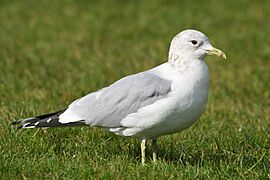Common gull facts for kids
Quick facts for kids Common gull |
|
|---|---|
 |
|
| Adult in breeding plumage, Norway | |
| Conservation status | |
| Scientific classification | |
| Genus: |
Larus
|
| Species: |
canus
|
The common gull (Larus canus), also known as the sea mew, is a medium-sized gull that lives and breeds in Europe and Asia. It's often called the "mew gull" in some places. Many common gulls travel to warmer places for winter. There are different ideas about how this bird got its name, "common gull."
The name "sea mew" comes from the Dutch name zeemeeuw, which also means "sea gull."
Contents
What Does the Common Gull Look Like?

Adult common gulls are about 40 to 46 centimeters (16 to 18 inches) long. They are smaller than the herring gull. They are also a bit smaller than the ring-billed gull. You can tell them apart by their bill. The common gull has a shorter, more pointed bill that is yellowish-green. It doesn't have any marks during breeding season.
Their bodies are grey on top and white underneath. Their legs are yellow when they are breeding. In winter, their legs become a duller color. In winter, their heads have grey streaks. Their bill often has a faint black band near the tip.
Common gulls have black wingtips with large white spots. These spots are called "mirrors." Young birds have black-brown feathers that look scaly on their upper parts. Their legs are pink, turning greyish in their second year. Then they become yellow. It takes them about three years to become fully grown. Their call sounds like a high-pitched "laughing" cry.
-
Breeding adult gulls have red rings around their dark eyes. This one is from Kizhi Island, Russia.
Types of Common Gulls
There are three main types, or subspecies, of the common gull. The Kamchatka gull is sometimes thought of as its own separate species.
- Common Gull (L. c. canus): This type is found in Europe and western Asia. It is the smallest subspecies. Its back is a medium grey. Its wingtips have a lot of black. Its eyes are dark. Young birds get white feathers on their head and belly. They have small dark marks. They have a wingspan of 110 to 125 cm (43 to 49 in). They weigh between 290 and 480 grams (10 to 17 oz).
- Russian Common Gull (L. c. heinei): This type lives in central northern Asia. It is larger than the European common gull. Its head is more sloped, making its bill look smaller. Its eyes are usually lighter. Its bill and legs are a deeper yellow. It has less dark marks on its bill in winter. Its wings are longer. It has more black on its wingtips than the European common gull. Young birds have whiter heads, bellies, and underwings. They have a clear black band on their tail. They weigh between 315 and 550 grams (11 to 19 oz).
- Kamchatka Gull (L. c. kamtschatschensis): This type is found in northeastern Asia. It is the largest subspecies. Its size is between the common gull and the ring-billed gull. Its head is more square-shaped. Its bill is thicker and longer. Its eyes are lighter, and its bill and legs are a deeper yellow. Its back is medium-dark grey. Its wingtips have a lot of black. Young birds keep their juvenile feathers longer. They look darker and browner overall. They weigh between 394 and 586 grams (14 to 21 oz).
The short-billed gull from North America used to be considered the same species. But now, most experts say it is a different species. This is because of differences in their genes, how they look, and their calls.
Where Do Common Gulls Live and What Do They Eat?
Common gulls often live in large groups near water or in marshy areas. They build nests on the ground or in small trees. A group can have anywhere from 2 to over 300 pairs of birds. They usually lay three eggs. The eggs hatch after about 24 to 26 days. The young birds are ready to fly after another 30 to 35 days.
Like most gulls, they eat many different things. They will search for food that others have left behind. They also hunt small animals. There are about one million pairs of common gulls in the world. Most of them, perhaps 80-90%, live in Europe.
Where Else Are They Seen?
The common gull sometimes visits the coast of eastern Canada in winter. It is also rarely seen in the northeastern USA. The Kamchatka gull is sometimes spotted in northwestern North America. This usually happens in spring. There is also one record of it in Newfoundland in autumn.
Why Is It Called the Common Gull?
The scientific name for the common gull comes from Latin. Larus means a gull or large seabird. Canus means "grey."
The name "common gull" was first used in 1768 by Thomas Pennant. He thought it was the most common type of gull. However, some people say the name means it feeds on "common land." This is land used for grazing animals. In many parts of Britain, the common gull is not actually the most common gull. Because of this, some people jokingly call it the "uncommon gull."
There are many old British names for this bird. They often sound like "maa," "mar," and "mew." The English word "mew" is related to the German word möwe and the Dutch word meeuw. In areas of Britain where Vikings had an influence, you might hear "maw" or "sea-maw." The word "gull" comes from an old Celtic language. It was first used in English in the 1400s. The modern Welsh word for gull is gwylan.






